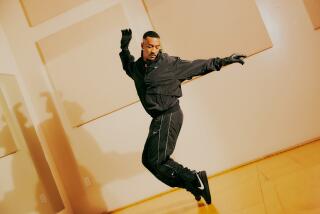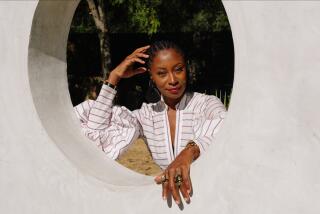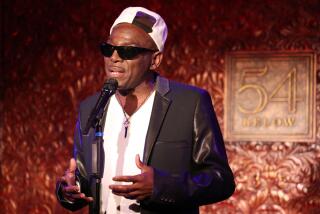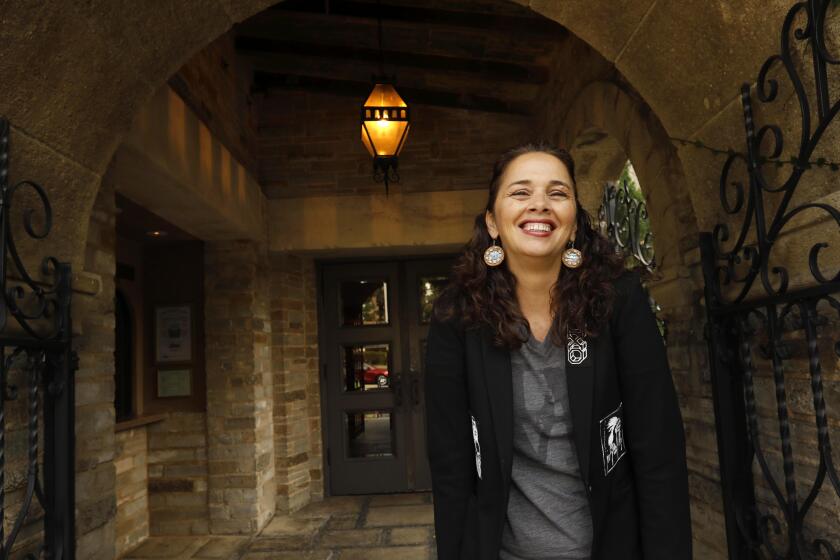Michael Trusnovec, Paul Taylor Dance Company poised to strike

NEW YORK — In “Banquet of Vultures,” veteran Paul Taylor Dance Company member Michael Trusnovec, dressed in a crisp black suit with a red power tie, yanks his bent knee toward his ear, conjuring up a bird of prey as he steps shrewdly through a mass of bodies. As he unfolds his talon-like hands, he evokes both a predator and a profiteer. Hands on hips, elbows splayed wide, he thrusts his leg back and swivels around a woman holding a candle, then tosses her overhead and onto the floor. With startling urgency, Trusnovec executes the sharp, scythe-sweeping movements of the choreography.
“Banquet of Vultures” is the central work on a program that the 17-member Paul Taylor Dance Company will present April 11 through 13 at the Music Center’s Dorothy Chandler Pavilion as part of the company’s 60th-anniversary season. The troupe, which hasn’t performed at the Music Center in 10 years, is headed by the man many consider to be the greatest living pioneer of modern dance as well as one of the most prolific and revered choreographers. Also included on the program are Taylor’s elegant “Airs” and the goofy “Gossamer Gallants.”
Taylor has explored the subject of war before in dances such as “Company B,” set to the music of the Andrews Sisters, “Sunset” and “Changes.” After “Banquet of Vultures” premiered in 2005, Taylor frankly stated that the central manipulative figure represented President George W. Bush and that the idea stemmed from the fact that his body didn’t lie.
CHEATSHEET: Spring 2014 arts preview
“It was the way George Bush walked — that pseudo-military thing,” says Taylor by phone. “He was putting it on — I guess he felt he had to.” As time has passed, the figure reads largely as a sinister archetype, a more malevolent version of Death from Kurt Jooss’ classic expressionistic antiwar ballet “The Green Table.”
In a rehearsal at the company’s light-flooded studio on Manhattan’s Lower East Side, among a patchwork of Chinese fruit vendors, old fabric warehouses and trendy doughnut shops, Trusnovec, who acts as a rehearsal director as well as the company’s most senior dancer, rehearses a quartet of men in “Banquet of Vultures” in choreography that manipulates them like marionettes. Dressed in an off-white singlet and gray tights, he scrutinizes the formations and adds his input to refine the choreography.
Trusnovec calls this work “the ultimate gift he gave to me” and emphasizes the uncharacteristic specificity of detail that Taylor outlined in the dance. “This is one of Paul’s darkest works,” says the 39-year-old Trusnovec, who has danced with the company for 16 years. “My character is ruthless, tyrannical and horrible. From Day 1 he kept talking to me about an authoritative figure leading troops, maybe a military general, and giving the war allusion.” (Trusnovec, however, didn’t hear the Bush imagery until he was at the Kennedy Center listening to Taylor give a post-performance discussion for the audience.)
PHOTOS: Best dance moments of 2013
For “Banquet of Vultures,” Opus 123 out of 140 works in Taylor’s prolific output, the 83-year-old choreographer chose minimalist composer Morton Feldman’s “Oboe and Orchestra,” a 1976 piece that features Feldman’s commitment to the indeterminacy movement, involving chance procedure in composition and performance. With its recurring asymmetric patterns and vague pitch shadings, the piece worms its way insidiously into the listener’s consciousness. The composition’s shrill, albeit mesmeric, quality with its oboe nudged into pinched, shrieking tones echoes the dance’s chaotic, clustered movement. Feldman made it known that he didn’t find “beautiful” music interesting and once stated, “In art, we must pursue anxiety.”
Taylor was aware of the possibly torturous effect of the score. “I didn’t find it hard to work with,” he says with a wicked chuckle. “I sometimes ignored it and sometimes went with it.”
If “Banquet” is one of Taylor’s bleakest works, the program’s opener, “Airs” show Taylor’s ability to pivot 180 degrees. It’s an almost balletic piece emblematic of an imaginary Valhalla of modern dance. “Airs,” created in 1978 for seven dancers, is performed to George Frideric Handel’s music from his operas “Alcina,” “Ariodante” and “Berenice” and the oratorio “Solomon,” along with sections of his “Concerti Grossi.”
“There’s a surprising weightiness to ‘Airs’ — a constant pressure against the air as if swimming through water,” says Trusnovec. “I love the way the dance plays with the constant sense of falling, as if the stage is tipping side to side.” In one section, Trusnovec and his partner dance a “fast/slow duet,” so-called because the tricky, off-balance partnering danced at allegro tempo is repeated in a subsequent adagio section. One of Taylor’s most popular works, “Airs” has appeared in the repertories of the Royal Danish Ballet, American Ballet Theater and the Birmingham Royal Ballet.
PHOTOS: Arts and culture in pictures by The Times
Taylor has often used Trusnovec’s versatility to shade to his wide spectrum of dances. “He can do anything — slow, fast, complicated,” says Taylor. “It’s his range that I admire the most.”
“Gossamer Gallants,” set to Bedrich Smetana’s romp from “The Bartered Bride,” represents the fluffy final course in the natural succession of a dance triple bill — appetizer, entree and dessert. Taylor, long an aficionado of the behavior of insects and other animals (and the way humans behave in alarmingly similar ways), crafted the dance — which seems to parody Jerome Robbins’ domineering female insects in his ballet “The Cage” — based on what he had observed in fireflies.
“The females can be very dangerous to the male,” says Taylor. “They have different kinds of blinks — long ones and short ones. It’s very tricky — they have a blink that the male thinks is something else — and that’s how they trap them. They kill the males once they’ve mated, so the males have to watch out. And that’s the way it is in the dance.”
Last month, Taylor stunned his board of directors and the dance community by announcing a “restructuring” of his company as part of its diamond-anniversary celebration and to allow the troupe to continue for 60 more years. The idea came partly from Taylor’s dismay at the disbanding of the Merce Cunningham Dance Company, as willed by the choreographer before his death.
Taylor, who remains active and choreographed two new pieces this season, says he would like to acquire other classic modern works by choreographers such as Martha Graham, José Limón, Doris Humphrey and the lesser-known Canadian-born Sybil Shearer. Perhaps more surprising is his desire to include postmodern choreographers such as Twyla Tharp and David Parsons. Taylor wants new repertoire, in addition to his own works, for the company’s 2015 Lincoln Center season.
“The plan is ready,” he says. “We’re going to start as soon as we can.”
MORE
PHOTOS: Hollywood stars on stage
PHOTOS: Arts and culture in pictures
More to Read
The biggest entertainment stories
Get our big stories about Hollywood, film, television, music, arts, culture and more right in your inbox as soon as they publish.
You may occasionally receive promotional content from the Los Angeles Times.






